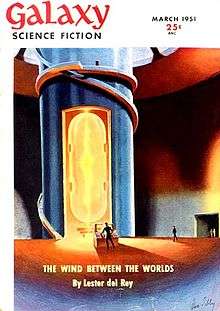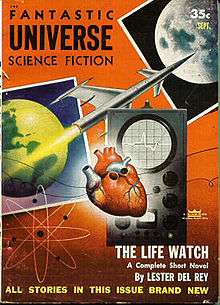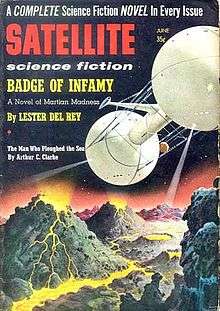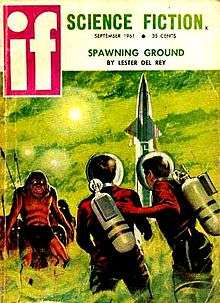Lester del Rey
| Lester del Rey | |
|---|---|
|
Judy-Lynn and Lester del Rey at Minicon in Minneapolis, 1974 | |
| Born |
Leonard Knapp June 2, 1915 Saratoga, Minnesota, United States |
| Died |
May 10, 1993 (aged 77) New York City, New York, United States |
| Pen name | John Alvarez, Marion Henry, Philip James, Philip St. John, Charles Satterfield, Erik van Lhin |
| Occupation | Writer, editor |
| Nationality | American |
| Period | 1938–1991 |
| Genre | Fantasy, science fiction |
| Spouse | Helen Schlaz (second of four, m. 1945), Evelyn Harrison, Judy-Lynn Benjamin |






Lester del Rey (June 2, 1915 – May 10, 1993) was an American science fiction author and editor. He was the author of many books in the juvenile Winston Science Fiction series, and the editor at Del Rey Books, the fantasy and science fiction imprint of Ballantine Books, along with his fourth wife Judy-Lynn del Rey.
Birth name
Del Rey often told people his real name was Ramon Felipe Alvarez-del Rey (and sometimes even Ramon Felipe San Juan Mario Silvio Enrico Smith Heartcourt-Brace Sierra y Alvarez del Rey y de los Uerdes). He also claimed that his family was killed in a car accident in 1935. However, his sister has confirmed that his name was really Leonard Knapp, and the accident in 1935 killed his first wife but not his parents, brother, or sister.[1]
Career
Del Rey first started publishing stories in pulp magazines in the late 1930s, at the dawn of the so-called Golden Age of Science Fiction. He was associated with the most prestigious science fiction magazine of the era, Astounding Science Fiction, from the time its editor John W. Campbell published his first short story in the April 1938 issue: "The Faithful", already under the name Lester del Rey. The December 1938 issue featured his story "Helen O'Loy" which was selected for the prestigious anthology The Science Fiction Hall of Fame. By the end of 1939 he had also placed stories in Weird Tales (edited by Farnsworth Wright) and Unknown (Campbell),[2] which featured more horror and more fantasy respectively. In the 1950s, del Rey was one of the main authors writing science fiction for adolescents (along with Robert A. Heinlein and Andre Norton). During this time some of his fiction was published under the name "Erik van Lhin".
During a period when del Rey's work was not selling well, he worked as a short order cook at the White Tower Restaurant in New York. After he married his second wife, Helen Schlaz, in 1945, he quit that job to write full-time. After meeting Scott Meredith at the 1947 World Science Fiction Convention, he began working as a first reader for the new Scott Meredith Literary Agency, where he also served as office manager.[3][4][5]
He later became an editor for several pulp magazines and then for book publishers. During 1952 and 1953, del Rey edited several magazines: Space SF, Fantasy Fiction, Science Fiction Adventures (as Philip St. John), Rocket Stories (as Wade Kaempfert), and Fantasy Fiction (as Cameron Hall).[6] Also during 1952, his first two novels were published in the Winston juvenile series, one with an Italian-language edition in the same year.[2]
In 1957, del Rey and Damon Knight co-edited a small amateur magazine named Science Fiction Forum. During a debate about symbolism within the magazine, del Rey accepted Knight's challenge to write an analysis of the James Blish story "Common Time" that showed the story was about a man eating a ham sandwich.[7]
Del Rey was most successful editing with his fourth wife, Judy-Lynn del Rey, at Ballantine Books (as a Random House property, post-Ballantine) where they established the fantasy and science fiction imprint Del Rey Books in 1977.[8] After science fiction gained respectability and began to be taught in classrooms, del Rey stated that academics interested in the genre should "get out of my Ghetto."[9][10] Del Rey stated that "to develop science fiction had to remove itself from the usual critics who viewed it from the perspective of [the] mainstream, and who judged its worth largely on its mainstream values. As part of that mainstream, it would never have had the freedom to make the choices it did – many of them quite possibly wrong, but necessary for its development."[11] For a number of years in the 1970s, Del Rey, himself, helmed the review column for Analog Science Fiction and Fact entitled The Reference Library.
Del Rey was a member of an all-male literary banqueting club, the Trap Door Spiders, which served as the basis of Isaac Asimov's fictional group of mystery solvers, the Black Widowers. Del Rey was the model for "Emmanuel Rubin".[12]
Awards
Del Rey was awarded the 1972 E. E. Smith Memorial Award for Imaginative Fiction (the "Skylark") by the New England Science Fiction Association for "contributing significantly to science fiction, both through work in the field and by exemplifying the personal qualities that made the late "Doc" Smith well-loved by those who knew him". He also won a special 1985 Balrog Award for his contributions to fantasy, voted by fans and organized by Locus Magazine. The Science Fiction Writers of America named him its 11th SFWA Grand Master in 1990, presented 1991.[13][14]
Selected works
Novels
- Marooned on Mars (1952)
- Rocket Jockey as Philip St. John (1952)
- Attack from Atlantis (1953)
- Battle on Mercury as Erik Van Lhin (1953)
- The Mysterious Planet as Kenneth Wright (1953)
- Rockets to Nowhere as Philip St. John (1954)
- Step to the Stars (1954)
- For I Am A Jealous People (1954)
- Preferred Risk (1955) with Frederik Pohl [as by Edson McCann]
- Mission to the Moon (1956)
- Nerves (1956)
- Police Your Planet as Erik Van Lhin (1956)
- Day of the Giants (1959)
- Moon of Mutiny (1961)
- The Eleventh Commandment (1962)
- Outpost of Jupiter (1963)
- The Sky Is Falling (1963)
- Badge of Infamy (1963)
- The Runaway Robot (1965)
- The Infinite Worlds of Maybe (1966)
- Rocket from Infinity (1966)
- The Scheme of Things (1966)
- Siege Perilous (1966)
- Tunnel Through Time (1966)
- Prisoners of Space (1968)
- Pstalemate (1971)
- Weeping May Tarry (1978) with Raymond F. Jones
Short fiction collections
- ... And Some Were Human (1948)
- Robots and Changelings (1957)
- The Sky is Falling and Badge of Infamy (1966)
- Mortals and Monsters (1965)
- Gods and Golems (1973)
- The Early del Rey (1975)
- The Early del Rey: Vol 1 (1976)
- The Early del Rey: Vol 2 (1976)
- The Best of Lester del Rey (1978)
- War and Space (2009)
- Robots and Magic (2010)
Nonfiction
- Rockets Through Space (1957)
- Space Flight, General Mills, Inc. 1958, 1957; Golden Press, 1959
- The Mysterious Earth (1960)
- The Mysterious Sea (1961)
- The Mysterious Sky (1964)
- The World of Science Fiction, 1926-1976: the History of a Subculture (1980)
As editor
- The Year After Tomorrow with Carl Carmer & Cecile Matschat (1954)
- Best Science Fiction of the Year #1-#5 (1972–1976)
References
- ↑ "People & Publishing". Locus. Locus Publications. January 2008. p. 8.
- 1 2 Lester del Rey at the Internet Speculative Fiction Database (ISFDB). Retrieved 2013-04-12. Select a title to see its linked publication history and general information. Select a particular edition (title) for more data at that level, such as a front cover image or linked contents.
- ↑ Moskowitz, Sam (1966). Seekers of Tomorrow. World Publishing Company. p. 181.
- ↑ Knight, Damon (1977). The Futurians. John Day. p. 180. ISBN 0-381-98288-2.
- ↑ Davin, Eric Leif (1999). "From Wisconsin to Mars: A Conversation with Raymond F. Gallun". Pioneers of Wonder: 216.
- ↑ Ashley, Michael (1975). The History of the Science Fiction Magazine, Vol. 3: 1946-1955. CBI. p. 331. ISBN 0-8092-7841-3.
- ↑ Knight, Damon (1996). In Search of Wonder. Advent:Publishers. p. 284. ISBN 0-911682-31-7.
- ↑ Davin, Eric Leif (1999). Pioneers of Wonder. Prometheus Books. p. 226. ISBN 1-57392-702-3.
- ↑ Letson, Russell (1994). "Contributions to the Critical Dialogue: As an Academic Sees It". Science Fiction Fandom: 230–232.
- ↑ Ashley, Michael (2007). Gateways to Forever: The Story of the Science Fiction Magazines from 1970-1980. Liverpool University Press. p. 295. ISBN 978-1-84631-003-4.
- ↑ Davin, Eric Leif (1999). Pioneers of Wonder. Prometheus Books. pp. 14–15. ISBN 1-57392-702-3.
- ↑ Asimov, Isaac (1994). I. Asimov: A Memoir. Doubleday. pp. 380–383. ISBN 0-385-41701-2.
- ↑ "del Rey, Lester". The Locus Index to SF Awards: Index to Literary Nominees. Locus Publications. Retrieved 2013-04-02.
- ↑ "Damon Knight Memorial Grand Master". Science Fiction and Fantasy Writers of America (SFWA). Retrieved 2013-04-02.
- Citations
- Tuck, Donald H. (1974). The Encyclopedia of Science Fiction and Fantasy. Chicago: Advent. pp. 135–136. ISBN 0-911682-20-1.
External links
- Works by Lester Del Rey at Project Gutenberg
- Works by or about Lester del Rey at Internet Archive
- Works by Lester del Rey at LibriVox (public domain audiobooks)

- Lester del Rey at the Internet Speculative Fiction Database
- Lester del Rey at Goodreads
- Lester del Rey at the Internet Book List